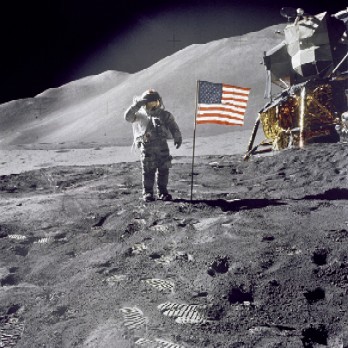





On January 14, 2004, ten days after the landing of the Mars Exploration Rover Spirit, US President George W. Bush announced a new plan for NASA's future, dubbed the Vision for Space Exploration. According to this plan, mankind will return to the Moon by 2018, and set up outposts as a testbed and potential resource for future missions. The Space Shuttle will be retired in 2010 and Orion will replace it by 2015, capable of both docking with the International Space Station (ISS) and leaving the Earth's orbit. The future of the ISS is somewhat uncertain – construction will be completed, but beyond that is less clear. Although the plan initially met with skepticism from Congress, in late 2004 Congress agreed to provide start-up funds for the first year's worth of the new space vision.
Hoping to spur innovation from the private sector, NASA established a series of Centennial Challenges, technology prizes for non-government teams, in 2004. The Challenges include tasks that will be useful for implementing the Vision for Space Exploration, such as building more efficient astronaut gloves.
NASA's ongoing investigations include in-depth surveys of Mars and Saturn and studies of the Earth and the Sun. Other NASA spacecraft are presently en route to Mercury and Pluto. With missions to Jupiter in planning stages, NASA's itinerary covers over half the solar system.
Managed by the NASA's Jet Propulsion Laboratory (JPL) in Pasadena, California, the Phoenix mission was launched on August 4, 2008. It will search for possible underground water courses in the northern Martian pole. This lander revives much of its experiments and instrumentation from the failed 1999 Mars Polar Lander, hence its name. An improved and larger rover, Mars Science Laboratory, is under construction and slated to launch in 2009. On the horizon of NASA's plans are two possibilities under consideration for the Mars Scout 2013 mission.
The New Horizons mission to Pluto was launched in 2006 and will fly by Pluto in 2015. The probe received a gravity assist from Jupiter in February 2007, examining some of Jupiter's inner moons and testing on-board instruments during the fly-by.
The Space Shuttle became the major focus of NASA in the late 1970s and the 1980s. Planned to be a frequently launchable and mostly reusable vehicle, four space shuttles were built by 1985. The first to launch, Columbia, did so on April 12, 1981.
The shuttle was not all good news for NASA – flights were much more expensive than initially projected, and the public again lost interest as missions appeared to become mundane until the 1986 Challenger disaster again highlighted the risks of space flight. Work began on Space Station Freedom as a focus for the manned space program, but within NASA there was argument that these projects came at the expense of more inspiring unmanned missions such as the Voyager probes.
Nonetheless, the shuttle launched milestone projects like the Hubble Space Telescope (HST). The HST is a joint project between NASA and the European Space Agency (ESA), and its success has paved the way for greater collaboration between the agencies. The HST was created with a relatively small budget of $2 billion but has continued operation since 1990, delighting both scientists and the public. Some of its images, such as the groundbreaking Hubble Deep Field, have become famous.
In 1995 Russian-American interaction resumed with the Shuttle-Mir missions. Once more an American vehicle docked with a Russian craft, this time a full-fledged space station. This cooperation continues to today, with Russia and America the two biggest partners in the largest space station ever built – the International Space Station (ISS). The strength of their cooperation on this project was even more evident when NASA began relying on Russian launch vehicles to service the ISS during the two year grounding of the shuttle fleet following the 2003 Space Shuttle Columbia disaster, which killed the crew of six Americans and one Israeli, caused a 29-month hiatus in space shuttle flights and triggered a serious re-examination of NASA's priorities. The U.S. government, various scientists, and the public all reconsidered the future of the space program.
Costing over $100 billion, it has been difficult at times for NASA to justify the ISS.[citation needed] The population at large has historically been hard to impress with details of scientific experiments in space, preferring news of grand projects to exotic locations.[citation needed] Even now, the ISS cannot accommodate as many scientists as planned.
During much of the 1990s, NASA was faced with shrinking annual budgets due to Congressional belt-tightening in Washington, D.C. In response, NASA's ninth administrator, Daniel Goldin, pioneered the "faster, better, cheaper" approach that enabled NASA to cut costs while still delivering a wide variety of aerospace programs (Discovery Program). That method was criticized and re-evaluated following the twin losses of Mars Climate Orbiter and Mars Polar Lander in 1999. Yet, NASA's shuttle program had made 116 successful launches as of December 2006.


